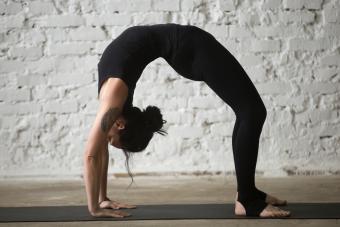
Wheel pose is one of those yoga asanas that looks like its name. It's an extreme backbend in which the body forms a half circle, round as a wheel, with the palms and feet on the mat. Also known as upward bow, urdhva dhanurasana or chakrasana in Sanskrit -- both names mean "wheel" -- the pose delivers a quick energy boost while giving you a more flexible spine, strengthening the arms, wrists, legs, shoulders and core, and lengthening the muscles along the entire front of the body.
Safely Assume the Wheel Shape
The inversion pose relieves body tension, so it lowers stress and may be approached from a standing or a prone position, depending on your strength and back flexibility. Start simple, from a supine position on your mat.
- Lie on your back, hands next to your ears, palms flat and elbows up in the air. Bend your knees and place both feet flat on the mat, as close as you can get them to your sitting bones.
- Inhale. Press your feet strongly into the floor. Exhale and push your tailbone and pubic bone up to the ceiling, firming and lifting the butt as it comes off the mat. Breathe calmly two or three times as you check your feet and thighs - both should remain parallel.
- Press your hands into the floor -- your shoulder blades will move back as you lift the upper body, resting the crown of your head lightly on the mat. The arms should also remain parallel. Breathe deeply and slowly two or three times in this position.
- Stabilize your feet and palms strongly against the floor and push up on the exhale, straightening your arms to raise your head off the mat. Direct your tailbone and your shoulder blades towards your spine, deepening the backwards curve. Think of lifting your pubic bones toward your navel and widening the space between your shoulder blades.
- Allow your neck to soften and your head to relax, or curve it so you can just see the floor. Breathe five to ten times, keeping a strong arch without tensing your muscles.
- Come out of the pose by tucking your chin to your chest, gently bending your arms and legs, and releasing your spine gradually to the mat.
- Repeat wheel pose three to ten times, checking in with yourself to gauge your energy and ability to do the inversion with good form.
Props and Modifications
Want to increase the challenge? Work on your balance while you add extra conditioning for your core. Once you are in full wheel pose, exhale, bend one knee and bring it in towards your body. Then inhale as you extend the bent leg so it is raised about 45 degrees from the floor (halfway to perpendicular). Hold the extended leg steady for a count of three to five slow deep breaths. Then exhale, bend the knee and gently lower the leg to the floor. Repeat with the other leg.
When injury or the level of challenge keeps you from doing the full-out pose, grab a handy prop or bolster and get the benefits while you get more fit.
- Brace yoga blocks against the wall and start the pose with your feet or hands on the blocks to lift you higher and give you more of a bend than your present strength can manage.
- Alternatively, place a body-length bolster in the center of your mat. Lie down on the bolster in the position to start wheel pose -- palms and soles of the feet on the floor. Taking just a slight weight on the hands for stability, push your pelvis up into bridge pose position and hold it there before lowering and raising it five to ten times. This takes the stress off your hands, wrists and arms and is good for people with weak wrists or shoulder problems.
Whole Body Benefits
Yoga Journal says wheel pose not only stretches your chest and lungs as it builds strength in your arms, legs, core and spine. It will also firm your glutes, build up your wrists and shoulders, and stimulate your thyroid and pituitary glands. The energy rush you get from an inversion like Wheel pose eases depression. The pose may be used therapeutically to relieve asthma, back pain and infertility. The strength-building counters osteoporosis.
However, you should not attempt an extreme backbend if you suffer from blood pressure problems, back injuries, carpal tunnel, heart disease or headaches. If you have any questions about whether the pose is appropriate for you, check with your health care provider or certified yoga instructor.







